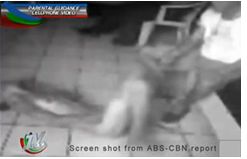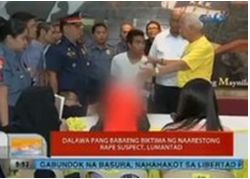
After the Anti-Torture Law was enforced, there have been two widely publicized torture videos where police officers were caught on camera torturing suspects in their custody. The first was in August 2010; the perpetrator was Joselito Binayug. The second was in June this year and the perpetrator was none other than Alfredo Lim, a former police officer and the former Mayor of Manila. What differs in these videos is only the background of the perpetrators. Lim is an influential person while Binayug was a little known police officer until his torture video was exposed. The gravity of the crimes they committed is similar: torture.
 Joselito Binayug caught torturing a robbery suspect inside the police station.
Joselito Binayug caught torturing a robbery suspect inside the police station.
After these torture videos were exposed, Binayug was subjected to an investigation; he was dismissed from police service on administrative charges, prosecuted for torture and is presently detained after he was arrested. On the other hand, Lim has yet to be subjected to an investigation. Nor have the police officers who did nothing to prevent him from torturing a rape suspect in full view of journalists while the television cameras were rolling. In these two cases, it is clear that while putting a low-ranking policeman in jail is likely to happen, it is not so for torturers who wield influence and power in Filipino society.
Lim is not an ordinary police officer. Before becoming a Manila Mayor, he was a Senator and, shortly after the EDSA revolution, was a former Director of the National Bureau of Investigation (NBI). The NBI is a special investigating body under the Department of Justice (DoJ) and is the Philippines’ equivalent to the US Federal Bureau Investigation (FBI). As a former director of the NBI, Lim therefore is assumed to have obtained training in investigation procedures. However, the video clearly proves that he prefers to use torture to extract confessions.
Lim’s example of torturing suspects, who have yet to be held accountable for any crime is the norm rather than the exception. There are many other policemen and soldiers who joined politics after retiring from the police and military service who now possess Executive and Legislative powers. They are now in politics but were never held accountable for the crimes of torture they committed in the past, let alone the extrajudicial killings, enforced disappearances and others forms of violations they committed while they were in service.
One clear example is Panfilo Lacson, a police colonel and former deputy commander of the now defunct Metrocom Intelligence Service Group (MISG) during the Marcos regime. He is a former Philippine Senator. Lacson is one of the 12 high ranking police officials who were accused of torturing twenty young men in the case of Aberca v. Ver in 1982. Lacson and many other former policemen and soldiers who routinely tortured suspects served in the legislature as lawmakers. None of the police officers accused in the Aberca case have been punished for torture.
Therefore, the distinction between Binayug and Lim is that the latter had more influential connections in the police and military than the former. If you have strong connections in the police and military escaping from criminal charges is easy. Lacson did this and was proud of his exploits, escaping in January 2010 before he could be indicted murder for allegedly masterminding the killing of a publicist and his driver. Lacson escape while he was sitting as a Senator.
 Alfredo Lim torturing a rape suspect in full view of the journalists, policemen.
Alfredo Lim torturing a rape suspect in full view of the journalists, policemen.
Lim’s case made it clear that torture, in practice, is not the serious criminal offense it is made out to be in the Anti-Torture Law. Lim gets away with it. The fact that Lim and the other policemen were never investigated to answer allegations of torture clearly reveals that the enforcement of this law is not equal. It rather depends on who the perpetrators are. It applies to Binayug but not to Lim and his ilk. It is blatantly clear that some individuals and sections of society are beyond the reach of this law.
In Binayug’s case, had it not been due to the graphic torture caught in the torture video exposed, both inside and outside the country, no investigation would have taken place. It was the public pressure, not through the ordinary enforcement of the Anti-Torture Law that made the investigation, prosecution and trial possible. In other cases, getting remedy is even more difficult when the act of torture is not caught on video, the victims and their families chose not to complain for lack protection and security. In fact, these types of cases have little possibility of getting remedies and redress in courts.
In Lim’s case, even though the crime and violation of torture that he and Binayug committed were similar it is likely that he will get away with it due to the influence and connections he still holds. Thus, regardless of the fact that Lim’s torture was caught on video, it does not really matter. He is not likely to face an investigation any time soon. Lim’s act of torture may not be as horrible as what Binayug (Lim did not pull the genitals of the rape suspect by a string); but, it still is torture and under the law any violator must be held to account.
To support this case, please click here: SEND APPEAL LETTER
SAMPLE LETTER